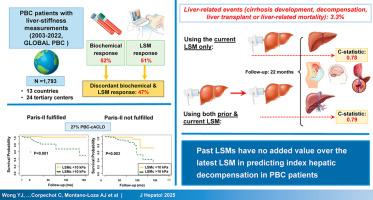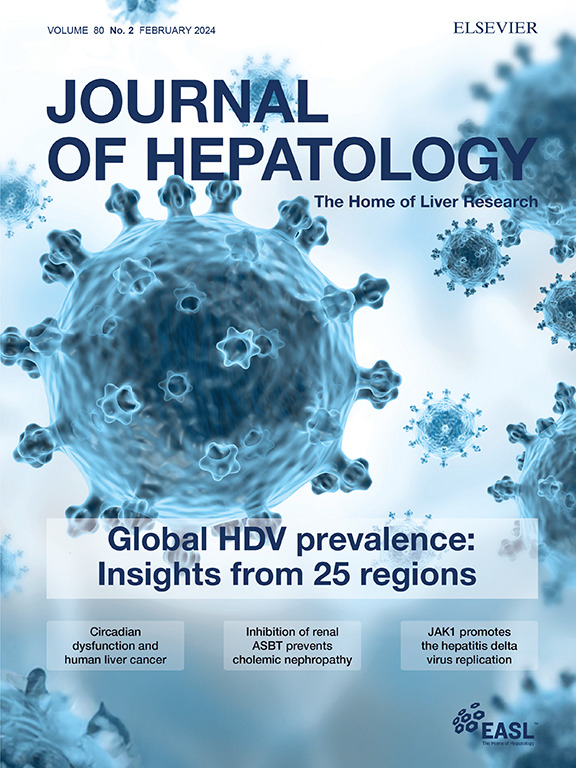Prognostic value of liver stiffness measurement vs. biochemical response in primary biliary cholangitis
IF 33
1区 医学
Q1 GASTROENTEROLOGY & HEPATOLOGY
引用次数: 0
Abstract
Background/aim
Both liver stiffness measurement (LSM) and biochemical response have prognostic significance in patients with primary biliary cholangitis (PBC). However, the frequency and clinical relevance of discordant biochemical and LSM changes remain unclear. We aim to determine the performance of the most recent or current LSM (LSMc) in predicting first hepatic decompensation (HD) in the setting of discordant biochemical and LSM responses.Methods
In this international, multicenter study, we included patients with at least two reliable LSM performed at least six months apart. Patients with prior HD, liver transplantation (LT) or hepatocellular carcinoma were excluded. Biochemical response was based on the Paris-2 criteria. LSM response was defined as stable or any reduction in LSM. The primary outcome was the occurrence of the first HD. Secondary outcomes were LT and liver-related death. The influence of LSM on HD was estimated using Cox regression analysis.Results
A total of 1,793 PBC patients were analyzed. Over a median follow-up of 22 (IQR: 12-39) months, 3.3% developed HD. Up to 55% of PBC patients exhibited discordance between LSM and biochemical response. Among patients with LSM response, achieving Paris-2 criteria was associated with a lower risk of HD (HR 0.25, 95%CI: 0.06-0.97, p<0.044). Among patients with biochemical response, LSM response did not influence the risk of developing HD (HR 0.64, 95%CI: 0.21-1.96, p=0.429). The LSMc >10 kPa strongly predicted HD (HR 14.5, 95% CI 6.9-30.6, p<0.001), irrespective of biochemical response and prior LSM trajectories.Conclusions
Discordance between LSM and biochemical response is frequent. Most recent or current LSM is the strongest predictor of first liver-related events in patients with PBC, irrespective of prior biochemical response or LSM trajectory.IMPACT AND IMPLICATIONS
Both liver stiffness measurement (LSM) and biochemical response have prognostic significance in patients with primary biliary cholangitis (PBC). However, the clinical relevance and how discordant biochemical and LSM changes should be best interpreted remain unclear. In this large international multicenter study, we demonstrated that once the current LSM (LSMc) is known, prior LSM trajectories and biochemical changes did not improve the prediction of liver-related events in patients with PBC.

肝硬度测量与原发性胆管炎生化反应的预后价值
背景/目的肝硬度测量(LSM)和生化反应在原发性胆道性胆管炎(PBC)患者中具有预后意义。然而,不一致的生化和LSM变化的频率和临床相关性尚不清楚。我们的目的是确定在生化和LSM反应不一致的情况下,最新或当前LSM (LSMc)在预测首次肝代偿(HD)方面的表现。方法在这项国际多中心研究中,我们纳入了至少两次可靠LSM相隔至少6个月的患者。排除既往HD,肝移植(LT)或肝细胞癌患者。生化反应是基于巴黎标准2。LSM反应被定义为稳定或任何LSM减少。主要结局是首次HD的发生。次要结局是肝移植和肝脏相关死亡。采用Cox回归分析估计LSM对HD的影响。结果共分析了1793例PBC患者。中位随访22个月(IQR: 12-39), 3.3%发生HD。高达55%的PBC患者表现出LSM和生化反应之间的不一致。在LSM应答的患者中,达到Paris-2标准与HD风险降低相关(HR 0.25, 95%CI: 0.06-0.97, p<0.044)。在生化反应的患者中,LSM反应不影响HD的发生风险(HR 0.64, 95%CI: 0.21-1.96, p=0.429)。LSMc >;10 kPa强烈预测HD (HR 14.5, 95% CI 6.9-30.6, p<0.001),而不考虑生化反应和先前的LSM轨迹。结论LSM与生化反应的不一致是常见的。最近或当前的LSM是PBC患者首次肝脏相关事件的最强预测因子,与先前的生化反应或LSM轨迹无关。影响和意义肝硬度测量(LSM)和生化反应对原发性胆道性胆管炎(PBC)患者的预后具有重要意义。然而,临床相关性以及如何最好地解释不一致的生化和LSM变化仍不清楚。在这项大型国际多中心研究中,我们证明,一旦已知当前的LSM (LSMc),先前的LSM轨迹和生化变化并不能改善PBC患者肝脏相关事件的预测。
本文章由计算机程序翻译,如有差异,请以英文原文为准。
求助全文
约1分钟内获得全文
求助全文
来源期刊

Journal of Hepatology
医学-胃肠肝病学
CiteScore
46.10
自引率
4.30%
发文量
2325
审稿时长
30 days
期刊介绍:
The Journal of Hepatology is the official publication of the European Association for the Study of the Liver (EASL). It is dedicated to presenting clinical and basic research in the field of hepatology through original papers, reviews, case reports, and letters to the Editor. The Journal is published in English and may consider supplements that pass an editorial review.
 求助内容:
求助内容: 应助结果提醒方式:
应助结果提醒方式:


